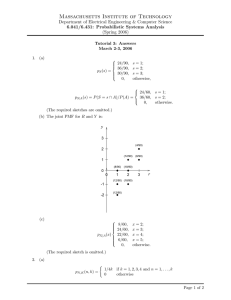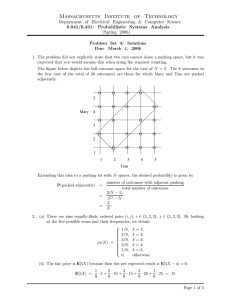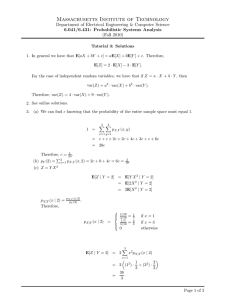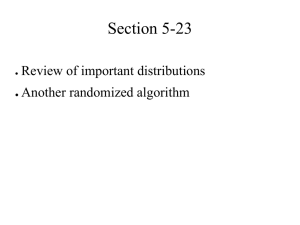Massachusetts Institute of Technology
advertisement
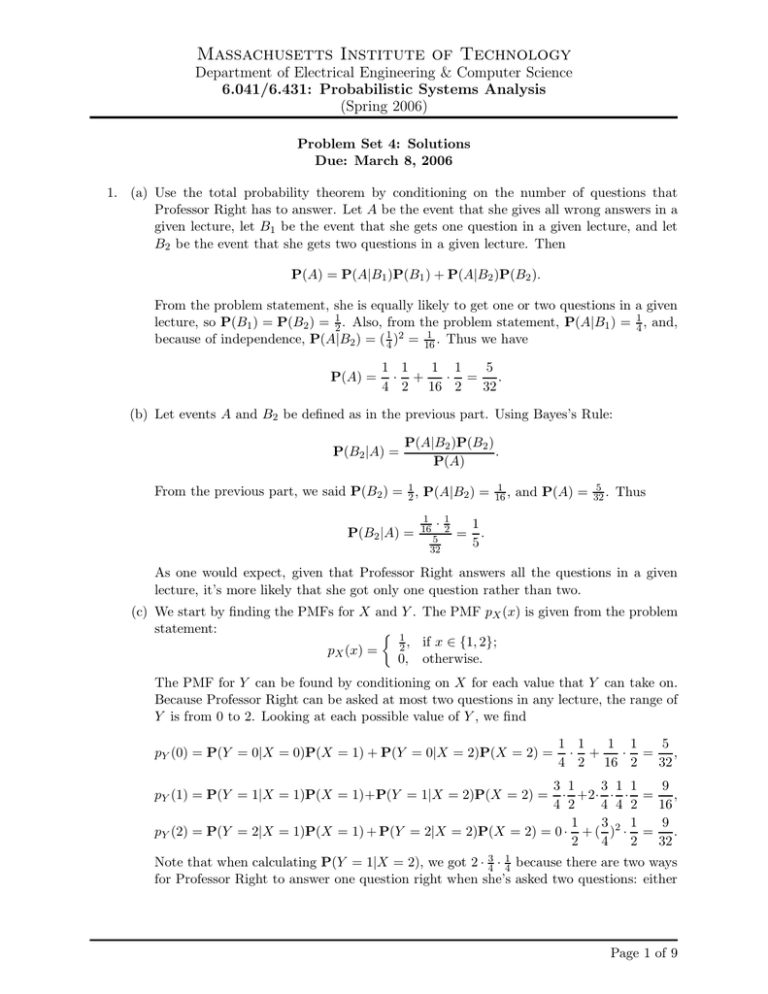
Massachusetts Institute of Technology
Department of Electrical Engineering & Computer Science
6.041/6.431: Probabilistic Systems Analysis
(Spring 2006)
Problem Set 4: Solutions
Due: March 8, 2006
1. (a) Use the total probability theorem by conditioning on the number of questions that
Professor Right has to answer. Let A be the event that she gives all wrong answers in a
given lecture, let B1 be the event that she gets one question in a given lecture, and let
B2 be the event that she gets two questions in a given lecture. Then
P(A) = P(A|B1 )P(B1 ) + P(A|B2 )P(B2 ).
From the problem statement, she is equally likely to get one or two questions in a given
lecture, so P(B1 ) = P(B2 ) = 12 . Also, from the problem statement, P(A|B1 ) = 14 , and,
1
. Thus we have
because of independence, P(A|B2 ) = ( 14 )2 = 16
P(A) =
1 1
1 1
5
· +
· = .
4 2 16 2
32
(b) Let events A and B2 be defined as in the previous part. Using Bayes’s Rule:
P(B2 |A) =
P(A|B2 )P(B2 )
.
P(A)
From the previous part, we said P(B2 ) = 21 , P(A|B2 ) =
P(B2 |A) =
1
16
·
5
32
1
2
=
1
16 ,
and P(A) =
5
32 .
Thus
1
.
5
As one would expect, given that Professor Right answers all the questions in a given
lecture, it’s more likely that she got only one question rather than two.
(c) We start by finding the PMFs for X and Y . The PMF pX (x) is given from the problem
statement:
1
2 , if x ∈ {1, 2};
pX (x) =
0, otherwise.
The PMF for Y can be found by conditioning on X for each value that Y can take on.
Because Professor Right can be asked at most two questions in any lecture, the range of
Y is from 0 to 2. Looking at each possible value of Y , we find
pY (0) = P(Y = 0|X = 0)P(X = 1) + P(Y = 0|X = 2)P(X = 2) =
1 1
5
1 1
· +
· = ,
4 2 16 2
32
3 1 1
9
3 1
· +2· · · = ,
4 2
4 4 2
16
3 2 1
9
1
pY (2) = P(Y = 2|X = 1)P(X = 1) + P(Y = 2|X = 2)P(X = 2) = 0 · + ( ) · = .
2
4
2
32
pY (1) = P(Y = 1|X = 1)P(X = 1)+P(Y = 1|X = 2)P(X = 2) =
Note that when calculating P(Y = 1|X = 2), we got 2 · 43 · 41 because there are two ways
for Professor Right to answer one question right when she’s asked two questions: either
Page 1 of 9
Massachusetts Institute of Technology
Department of Electrical Engineering & Computer Science
6.041/6.431: Probabilistic Systems Analysis
(Spring 2006)
she answers the first question correctly or she answers the second question correctly.
Thus, overall
5/32, if y = 0;
9/16, if y = 1;
pY (y) =
9/32, if y = 2;
0,
otherwise.
Now the mean and variance can be calculated explicitly from the PMFs:
1
3
1
+2· = ,
2
2
2
2
3
3 21
1
1
var(X) = 1 −
+ 2−
= ,
2
2
2
2
4
9
9
9
5
+1·
+2·
= ,
E[Y ] = 0 ·
32
16
32
8
2
2
9
5
9
9
9 2 9
27
var(Y ) = 0 −
+ 1−
+ 2−
= .
8
32
8
16
8
32
64
E[X] = 1 ·
(d) The joint PMF pX,Y (x, y) is plotted below. There are only five possible (x, y) pairs. For
each point, pX,Y (x, y) was calculated by pX,Y (x, y) = pX (x)pY |X (y|x).
y
9/32
2
3/8
3/16
1/8
1/32
1
2
1
0
x
(e) By linearity of expectations,
E[Z] = E[X + 2Y ] = E[X] + 2E[Y ] =
3
9
15
+2· = .
2
8
4
Calculating var(Z) is a little bit more tricky because X and Y are not independent;
therefore we cannot add the variance of X to the variance of 2Y to obtain the variance
of Z. (X and Y are clearly not independent because if we are told, for example, that
X = 1, then we know that Y cannot equal 2, although normally without any information
about X, Y could equal 2.)
To calculate var(Z), first calculate the PMF for Z from the joint PDF for X and Y . For
each (x, y) pair, we assign a value of Z. Then for each value z of Z, we calculate pZ (z)
by summing over the probabilities of all (x, y) pairs that map to z. Thus we get
1/8, if z = 1;
1/32, if z = 2;
3/8, if z = 3;
pZ (z) =
3/16, if z = 4;
9/32, if z = 6;
0,
otherwise.
Page 2 of 9
Massachusetts Institute of Technology
Department of Electrical Engineering & Computer Science
6.041/6.431: Probabilistic Systems Analysis
(Spring 2006)
In this example, each (x, y) mapped to exactly one value of Z, but this does not have to
be the case in general. Now the variance can be calculated as:
15 2 1
15 2 3
15 2 3
15
9
15 2 43
1
+
+
+
= .
1−
2−
3−
4−
+
6−
var(Z) =
8
4
32
4
8
4
16
4
32
4
16
(f) For each lecture i, let Zi be the random variable associated with the number of questions
Professor Right gets asked plus two times the number she gets right. Also, for each
lecture i, let Di be the random variable 1000 + 40Zi . Let S be her semesterly salary.
Because she teaches a total of 20 lectures, we have
S=
20
X
Di =
20
X
1000 + 40Zi = 20000 + 40
Zi .
i=1
i=1
i=1
20
X
By linearity of expectations,
20
X
Zi ] = 20000 + 40(20)E[Zi ] = 23000.
E[S] = 20000 + 40E[
i=1
Since each of the Di are independent, we have
var(S) =
20
X
var(Di ) = 20var(Di ) = 20var(1000 + 40Zi ) = 20(402 var(Zi )) = 36000.
i=1
(g) Let Y be the number of questions she will answer wrong in a randomly chosen lecture.
We can find E[Y ] by conditioning on whether the lecture is in math or in science. Let
M be the event that the lecture is in math, and let S be the event that the lecture is in
science. Then
E[Y ] = E[Y |M ]P(M ) + E[Y |S]P(S).
Since there are an equal number of math and science lectures and we are choosing
randomly among them, P(M ) = P(S) = 12 . Now we need to calculate E[Y |M ] and
E[Y |S] by finding the respective conditional PMFs first. The PMFs can be determined
in an manner analagous to how we calculated the PMF for the number of correct answers
in part (c).
· 43 + 12 ( 34 )2 = 21/32,
if y = 0;
1
1
1 3
· 4 + 2 · 2 · 4 · 4 = 5/16, if y = 1;
pY |S (y) =
· 0 + 21 ( 14 )2 = 1/32,
if y = 2;
0,
otherwise.
1 9
9 2
· + 12 ( 10
) = 171/200,
if y = 0;
21 10
1
1
1
9
2 · 10 + 2 · 2 · 10 · 10 = 7/50, if y = 1;
pY |M (y) =
1 2
1
· 0 + 12 ( 10
) = 1/200,
if y = 2;
2
0,
otherwise.
Therefore
1
2
1
2
1
2
E[Y |S] = 0 ·
21
5
1
3
+1·
+2·
= ,
32
16
32
8
Page 3 of 9
Massachusetts Institute of Technology
Department of Electrical Engineering & Computer Science
6.041/6.431: Probabilistic Systems Analysis
(Spring 2006)
E[Y |M ] = 0 ·
171
7
1
3
+1·
+2·
= .
200
50
200
20
This implies that
E[Y ] =
21
3 1 3 1
· + · = .
20 2 8 2
80
2. The key to the problem is the even symmetry with respect to x of pX,Y (x, y) combined with
the odd symmetry with respect to x of xy 3 .
By definition,
E[XY 3 ] =
5 X
10
X
xy 3 pX,Y (x, y).
x=−5 y=0
All the x = 0 terms make no contribution to sum above because xy 3 pX,Y (x, y) x=0 = 0.
The term for any pair (x, y) with x 6= 0 can be paired with the term for (−x, y). These terms
cancel, so the summation above is zero. Thus, without making in more detailed computations
we can conclude E[XY 3 ] = 0.
3. (a) Let Li be the event that Joe played the lottery on week i, and let Wi be the event that
he won on week i. We are asked to find
P(Li | Wic ) =
p − pq
(1 − q)p
P(Wic | Li )P(Li )
=
.
=
c
c
c
c
P(Wi | Li )P(Li ) + P(Wi | Li )P(Li )
(1 − q)p + 1 · (1 − p)
1 − pq
(b) Conditioned on X, the random variable Y is binomial:
x
q y (1 − q)(x−y) , 0 ≤ y ≤ x;
y
pY |X (y | x) =
0,
otherwise.
(c) Realizing that X has a binomial PMF, we have
pX,Y (x, y) = pY |X (y | x)pX (x)
x
n
y
(x−y)
q (1 − q)
px (1 − p)(n−x) , 0 ≤ y ≤ x ≤ n;
=
y
x
0,
otherwise.
(d) Using the result from (c), we could compute
pY (y) =
n
X
pX,Y (x, y) ,
x=y
but the algebra is messy. An easier method is to realize that Y is just the sum of
n independent Bernoulli random variables, each having a probability pq of being 1.
Therefore Y has a binomial PMF:
n
(pq)y (1 − pq)(n−y) , 0 ≤ y ≤ n;
pY (y) =
y
0,
otherwise.
Page 4 of 9
Massachusetts Institute of Technology
Department of Electrical Engineering & Computer Science
6.041/6.431: Probabilistic Systems Analysis
(Spring 2006)
(e)
pX,Y (x, y)
pY (y)
0
1
0 1
x
@ Aqy (1−q)(x−y) @ n Apx(1−p)(n−x)
y
x
0 1
, 0 ≤ y ≤ x ≤ n;
=
n A y
(n−y)
@
(pq) (1−pq)
y
0,
otherwise.
pX|Y (x | y) =
(f) Given Y = y, we know that Joe played y weeks with certainty. For each of the remaining
n − y weeks that Joe did not win there are x − y weeks where he played. Each of these
events occured with probability P(Li | Wic ) (the answer from part (a) ). Using this logic
we see that that X conditioned on Y is binomial:
n−x
n − y p−pq x−y
p−pq
1
−
, 0 ≤ y ≤ x ≤ n;
1−pq
1−pq
pX|Y (x | y) =
x−y
0,
otherwise.
After some algebraic manipulation, the answer to (e) can be shown to be equal to the
one above.
4. (a) V and W cannot be independent. Knowledge of one random variable gives information
about the other. For instance, if V = 12 we know that W = 0.
(b) We begin by drawing the joint PMF of X and Y .
y
(1/9)
(1/9)
(1/9)
(1/9)
(1/9)
(1/9)
(1/9)
(1/9)
(1/9)
8
6
v=
v=
4
v=
1
0
1
v=
2
12
v=
3
0
0
1
2
3
x
X and Y are uniformly distributed so each of the nine grid points has probability 1/9.
The lines on the graph represent areas of the sample space in which V is constant. This
constant value of V is indicated on each line. The PMF of V is calculated by adding the
probability associated with each grid point on the appropriate line.
Page 5 of 9
Massachusetts Institute of Technology
Department of Electrical Engineering & Computer Science
6.041/6.431: Probabilistic Systems Analysis
(Spring 2006)
pV(v)
1/3
2/9
1/9
4
6
8
10
v
12
By symmetry (or direct calculation), E[V ] = 8 . The variance is:
var(V ) = (4 − 8)2 ·
1
2
2
1
+ (6 − 8)2 · + 0 + (10 − 8)2 · + (12 − 8)2 · =
9
9
9
9
16
3
.
Alternatively, note that V is twice the sum of two independent random variables, V =
2(X + Y ), and hence
var(V ) = var 2(X +Y ) = 22 var(X +Y ) = 4 var(X)+var(Y ) = 4·2 var(X) = 8 var(X).
(Note the use of independence in the third equality; in the fourth one we use the fact
that X and Y are identically distributed, therefore they have the same variance). Now,
by the distribution of X, we can easily calculate that
1
1
1
2
var(X) = (1 − 2)2 + (2 − 2)2 + (3 − 2)2 = ,
3
3
3
3
so that in total var(V ) =
16
3 ,
as before.
(c) We start by adding lines corresponding to constant values of W to our first graph in
part (b):
0
w=
-1
w=
1
12
v=
3
w=
w=
-2
y
w=
2
10
v=
2
8
v=
6
v=
4
v=
1
0
0
1
2
3
x
Again, each grid point has probability 1/9. Using the above graph, we get pV,W (v, w).
Page 6 of 9
Massachusetts Institute of Technology
Department of Electrical Engineering & Computer Science
6.041/6.431: Probabilistic Systems Analysis
(Spring 2006)
w
(1/9)
2
(1/9) (1/9)
1
(1/9) (1/9) (1/9)
0
(1/9) (1/9)
-1
(1/9)
-2
4 6 8 10 12
(d) The event W > 0 is shaded below:
w
v
(1/9)
W>0
2
(1/9) (1/9)
1
(1/9) (1/9) (1/9)
0
(1/9) (1/9)
-1
(1/9)
-2
4 6 8 10 12
v
By symmetry (or an easy calculation), E[V | W > 0] = 8 .
(e) The event {V = 8} is shaded below:
w
V=8
2
1
0
-1
-2
4 6 8 10 12
v
When V = 8, W can take on values in the set {−2, 0, 2} with equal probability. By
symmetry (or an easy calculation), E[W | V = 8] = 0. The variance is:
var(W | V = 8) = (−2 − 0)2 ·
1
1
1
+ (0 − 0)2 · + (2 − 0)2 · =
3
3
3
8
3
.
(f) Please refer to the first graph in part (b). When V = 4, X = 1 with probability 1.
When V = 6, X can take on values in the set {1, 2} with equal probability. Continuing
this reasoning for the other values of V , we get the following conditional PMFs, which
we plot on one set of axes.
Page 7 of 9
Massachusetts Institute of Technology
Department of Electrical Engineering & Computer Science
6.041/6.431: Probabilistic Systems Analysis
(Spring 2006)
x
(1/3) (1/2) (1)
3
2
1
(1/2) (1/3) (1/2)
(1) (1/2)(1/3)
4 6 8 10 12
v
Note that each column of the graph is a separate conditional PMF and that the probability of each column sums to 1. This part of the problem illustrates an important point.
pX|V (x | v) is actually not a single PMF but a family of PMFs.
p (x|v=4)
p (x|v=6)
X|V
X|V
p (x|v=8)
X|V
p (x|v=10)
X|V
p (x|v=12)
X|V
1
1
1/2
1/2
1/3
1
x
1 2 x
1 2 3 x
2 3 x
3
5. This probem asks for basic use of the probability density function.
(a) The probability that you wait more than 15 minutes is:
Z ∞
x ∞
1 −x
e 15 dx = −e− 15 = e−1 .
15
15 15
(b) The probability that you wait between 15 and thirty minutes is:
Z 30
x 30
1 −x
e 15 dx = −e− 15 = e−1 − e−2 .
15
15 15
G1† . (a) Clark must drive 12 block lengths to work, and each path is uniquely defined by saying
which 7 of those 12 block lengths is traveled East. For instance, the path
indicated by
12
the heavy line is (E,E,E,E,E,N,N,N,N,N,E,E). There are a total of 7 or 792 paths.
1
The probability of picking any one path is 792
.
(b) Out of 792 paths, the ones of interest
travel from point A to C and
then from point C
to point B. Paths from A to C: 74 = 35. Paths from C to B: 53 = 10. Paths from A
to C to B: 350. Thus, the probability of passing through C is 350
792 .
(c) If Clark was seen at point D, he must have reached the intersection of 3rd St. and 3rd
Ave. The
Paths from intersection
reasoning from this point is similar to that 5above.
6
to B: 4 = 15. Paths from intersection to C to B: 3 = 10. Thus the conditional
probability of passing through C after being sighted at D is 23 .
Page 8 of 9
x
Massachusetts Institute of Technology
Department of Electrical Engineering & Computer Science
6.041/6.431: Probabilistic Systems Analysis
(Spring 2006)
(d) Paths from Main and Broadway to wth and hth: w+h
w .
Paths from Main and Broadway to xth and yth: x+y
x .
(w−x)+(h−y)
Paths from x and y to wth and hth:
.
(w−x)
(x+y)((w−x)+(h−y)
)
(w−x)
Thus the probability of passing by the phone booth is x
.
w+h
( w )
(y0)((h−y)
0 )
= 1, which is reasonable since
(h0)
Clark must pass by the phone booth if there’s only one route to work.
ii. If h = 0, then y = 0. Similarly, the probability is 1.
i. If w = 0, then x = 0. The probability is
† Required
for 6.431; optional for 6.041
Page 9 of 9

